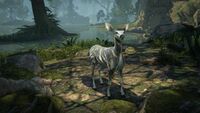Lore:Faun
| Fauns | |||
|---|---|---|---|
 A Faun Lord
A Faun Lord |
|||
| Type | Race (Beastfolk) | ||
| Range | Systres, West Weald (historically) | ||
| Appears in | |||
Fauns (sometimes called deerfolk)[1] are deerlike trickster[2] beastfolk native to the Systres, where they ecologically fill a similar role that goblins do for most of mainland Tamriel.[3] Rumors exist of creatures of nature either Man or Mer in appearance being the first inhabitants of the archipelago.[4] Fauns themselves are described as having bodies of tall, slender Mer,[5] and are confirmed to have been on the Systres isle of Galen before the Druids of Galen settled there.[6]
Contents
History[edit]
—Here-Seen[7]
In ancient history, a tribe of Fauns on mainland Tamriel, contemporary with the Lilmothiit, were wiped out by elven invaders. The only survivor was a Faun known as Here-Seen, who kept a journal detailing the events and swore he'd avenge his tribe.[7]
Fauns were a somewhat common sight in the West Weald circa 2E 582. This was a time of explosive plant growth, which resulted in the formation of the Dawnwood, a jungle that more closely resembled the forests of Valenwood.[8] By the end of the Third Era, these historic Faun populations were seemingly no longer present in Cyrodiil.[9]
Behavior and Culture[edit]
Female Fauns seem to either be rare or not exist, causing speculation of them reproducing via magical means, non-traditional methods, or females simply being kept well hidden. Fauns appear not to have their own verbal language, and communicate in simple grunts and chirps.[5] Fauns utilize rune-like lettering which is a part of their obscure dialect.[1]
According to Lady Arabelle Davaux, almost every known encounter with a Faun and the other denizens of Tamriel ends in violence. These violent tendencies have prevented a further understanding of their dialect and culture from developing.[3] One documented tale describes a particularly cruel encounter with a Faun during which they attacked a water carrier without clear provocation, strung him up upside down, stuffed his mouth full of garlic cloves, smothered him in honey, and then agitated a nearby hornet's nest before leaving him to his fate.[10] This position is contradicted by the House Dufort representative Parisse Plouff, who described them as protectors of nature who usually aren't vicious.[11]
Fauns dwell in herds which function as close-knit families.[6] Faun Lords hold a leadership role among Fauns, and have been known to turn the hunt around on hunters active in their territory. They are also noted for their magical abilities, and for being able to "turn the forest itself against intruders". This seems to even extend to allowing them to command Spriggans and Indriks in battle.[11][12][13] Some nature spirits called from the Green are bound into the forms of Fauns.[14]
A particular species of deer native to the Systres is sometimes believed to be young Fauns due to the similar markings they share. The juveniles are known to locals as Faun Fawns, and it is said that the Fauns call to them during their frolics.[15] Fauns have even been known to domesticate deer, as in the case of the Faunfrolic Great Elk, a large species of elk that bears a striking resemblance to Faun Fawns. These elks were bred by a band of Fauns who were inspired by the mounted knights of Castle Navire, although these efforts ceased when the Fauns realized their hooves made it difficult to ride. Furthermore, due to their natural speed, Fauns can easily keep pace with an elk.[16]
Cultural Impact[edit]
Although they reject outside observation, Fauns have still left an impact on the Bretons that share their island homeland. Fauns can be found depicted on decorations and as children's toys.[17][18] Their hooves are kept as good luck amulets.[19] A specific type of flute used by druids is rumored to have originated from a group of Fauns willingly showing them how to make them.[20] Although of no use to the Fauns themselves, the Faunfrolic Great Elk has been adopted as an exotic mount by the other races of Tamriel.[16]
Fauns are among the creatures kept in Hermaeus Mora's Feral Gallery, a collection of creatures in Apocrypha maintained by the Daedric Prince.[21]
Gallery[edit]
Notes[edit]
- It is unknown if Fauns are related to the Satyrs of ancient Valenwood. Fauns and Satyrs are often conflated in fantasy settings. Mainland Fauns were known to reside near Valenwood,[22] and once suffered an invasion from elves.[7] Satyrs were said to inhabit Valenwood before the arrival of the Aldmer.[23]
See Also[edit]
- Faun Names
- For game-specific information, see the Elder Scrolls Online article.
References[edit]
- ^ a b Faun's Lark Cladding antiquity codex entries in ESO
- ^ Corruption of Root's dialogue in ESO: Lost Depths
- ^ a b Loremaster's Archive - Bretons & High Isle — Lady Arabelle
- ^ Sorrows of the Wind — Bastibien Marolles, Historian
- ^ a b The Flora and Fauna of Galen — Elise Aglilmir, Traveling Naturalist
- ^ a b Druid Edaen's dialogue in ESO: Firesong
- ^ a b c Ancient Hunter's Journal — Here-Seen
- ^ Fauns in West Weald in ESO
- ^ West Weald in Oblivion
- ^ A Hunter's Journey VI: Fauns
- ^ a b Parisse Plouff's dialogue in ESO: High Isle
- ^ Events of Wildhorn's Wrath in ESO: High Isle
- ^ Hunter Marwig's dialogue in ESO: High Isle
- ^ Frii's dialogue in ESO: Firesong
- ^ Faun Fawn pet in ESO
- ^ a b Faunfrolic Great Elk mount in ESO
- ^ Faun Feast Decanter contraband description in ESO
- ^ Plush Faun contraband descriptions in ESO
- ^ Faun Hoof contraband description in ESO
- ^ Druid's Whispering Willow Flute contraband description in ESO
- ^ The Feral Gallery in ESO
- ^ Fauns in ESO
- ^ Pocket Guide to the Empire, 3rd Edition: The Wilds Remain: Valenwood — Imperial Geographical Society, 3E 432
|
|||||||||||||||||||||||||||||||||||||||||||





